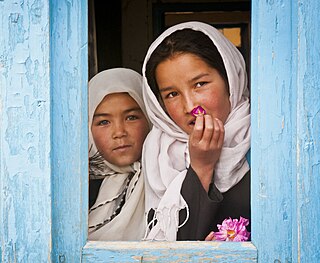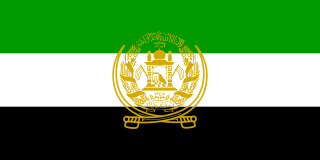
Afghans or Afghan people are nationals or citizens of Afghanistan, or people with ancestry from there. Afghanistan is made up of various ethnicities, of which Pashtuns, Tajiks, Hazaras and Uzbeks are the largest. The two main languages spoken by Afghans are Pashto and Dari, and many Afghans are bilingual in speaking fluent Pashto and Dari.

The Hazaras are an ethnic group and a principal component of the population of Afghanistan, native to, and primarily residing in the Hazaristan region in central Afghanistan and the northern regions of the Baluchistan province in Pakistan. They are one of the largest ethnic groups in Afghanistan, and a significant minority group in Pakistan, mostly in Quetta, and as well as in Iran. They speak the Dari and Hazaragi dialects of Persian. Dari is one of the two official languages in Afghanistan.

Mohammad Daoud Khan, also romanized as Daud Khan or Dawood Khan, was an Afghan statesman who served as prime minister of Afghanistan from 1953 to 1963 and, as leader of the 1973 Afghan coup d'état which overthrew the monarchy, served as the first president of Afghanistan from 1973 until his assassination.

Pashtunistan is a historical region located on the Iranian Plateau, inhabited by the indigenous Pashtun people of southern Afghanistan and northwestern Pakistan in South-Central Asia, wherein Pashtun culture, the Pashto language, and Pashtun identity have been based. Alternative names historically used for the region include Pashtūnkhwā (پښتونخوا), Pakhtūnistān, Pathānistān, or simply the Pashtun Belt. Pashtunistan borders the geographical regions of Turkestan to the north, Kashmir to the northeast, Punjab to the east, Balochistan to the south and Iran to the west.

The population of Afghanistan is around 41 million as of 2023. The nation is composed of a multi-ethnic and multilingual society, reflecting its location astride historic trade and invasion routes between Central Asia, South Asia, and Western Asia. Ethnic groups in the country include Pashtun, Tajik, Hazara, Uzbeks as well as smaller groups such as Nuristanis, Aimaq, Turkmen, Baloch and some others which are less known. Together they make up the contemporary Afghan people.
The 1998 Mazar-i-Sharif massacre took place in Mazar-i-Sharif, Afghanistan in 1998, and it involved at least 2,000 victims who were massacred by the Taliban, with Human Rights Watch estimating that the actual number of victims may be much higher.

Balkh is one of the 34 provinces of Afghanistan, located in the north of the country. It is divided into 15 districts and has a population of about 1,509,183, which is multi-ethnic and mostly a Persian-speaking society. The city of Mazar-i-Sharif serves as the capital of the province. The Mazar-i-Sharif International Airport and Camp Marmal sit on the eastern edge of Mazar-i-Sharif.

The Northern Alliance, officially known as the United Islamic National Front for the Salvation of Afghanistan, was a military alliance of groups that operated between late 1996 to 2001 after the Islamic Emirate of Afghanistan (Taliban) took over Kabul. The United Front was originally assembled by key leaders of the Islamic State of Afghanistan, particularly president Burhanuddin Rabbani and former Defense Minister Ahmad Shah Massoud. Initially it included mostly Tajiks but by 2000, leaders of other ethnic groups had joined the Northern Alliance. This included Karim Khalili, Abdul Rashid Dostum, Abdullah Abdullah, Mohammad Mohaqiq, Abdul Qadir, Asif Mohseni, Amrullah Saleh and others.

Abdul Haq was an Afghan mujahideen commander who fought against the Soviet-backed People's Democratic Party of Afghanistan, the de facto Afghan government in the 1980s. He was killed by the Taliban in October 2001 while trying to create a popular uprising against the Taliban in Afghanistan in the wake of the September 11th attacks.

The 1992–1996 Afghan Civil War took place between 28 April 1992—the date a new interim Afghan government was supposed to replace the Republic of Afghanistan of President Mohammad Najibullah—and the Taliban's conquest of Kabul establishing the Islamic Emirate of Afghanistan on 27 September 1996.

The 1996–2001 Afghan Civil War took place between the Taliban's conquest of Kabul and their establishing of the Islamic Emirate of Afghanistan on 27 September 1996, and the US and UK invasion of Afghanistan on 7 October 2001: a period that was part of the Afghan Civil War that had started in 1989, and also part of the war in Afghanistan that had started in 1978.

Afghanistan is a multiethnic and mostly tribal society. The population of the country consists of numerous ethnolinguistic groups: mainly the Pashtun, Tajik (~25%), Hazara (~10%) and Uzbek people (~10%), and minorities of Aimaq, Turkmen, Baloch, Pashai, Nuristani, Kurds, Gujjar, Arab, Brahui, Qizilbash, Pamiri, Kyrgyz, Sadat and others (~5%). Altogether they make up the Afghan people.

The National Islamic Movement of Afghanistan, sometimes called simply Junbish, is a Turkic political party in Afghanistan. Its founder is Marshal Abdul Rashid Dostum who created it in 1992 made from his loyalist remnants from the People's Democratic Party of Afghanistan's communist regime.
The Battles of Mazar-i-Sharif were a part of the Afghan Civil War and took place in 1997 and 1998 between the forces of Abdul Malik Pahlawan and his Hazara allies, Junbish-e Milli-yi Islami-yi Afghanistan, and the Taliban.

The Hazaras have long been the subjects of persecution in Afghanistan. The Hazaras are mostly from Afghanistan, primarily from the central regions of Afghanistan, known as Hazarajat. Significant communities of Hazara people also live in Quetta, Pakistan, and in Mashad, Iran, as part of the Hazara and Afghan diasporas.

The National Front of Afghanistan, or Jabh-e Melli, was established in late 2011 by Ahmad Zia Massoud, Haji Mohammad Mohaqiq and Abdul Rashid Dostum. It was generally regarded as a reformation of parts of the military wing which once existed of the United Front which with U.S. air support removed the Taliban from power in Afghanistan in late 2001. The National Front strongly opposed a return of the Taliban to power but failed to keep them in check. It retains only a small military apparatus today. The chairman of the National Front is Ahmad Zia Massoud, the younger brother of the Northern Alliance leader Ahmad Shah Massoud who was assassinated two days before the September 11 attacks in 2001. It is unclear if it is still in operation, as Afghanistan's Republican government has collapsed.
Anti-Pashtun sentiment refers to dislike and hostility towards Pashtuns, Pashtun culture, or the Pashto language. This includes fear as well as resentment exhibited by non-Pashtun ethnic majorities who have suffered decades of persecution at the hands of Pashtuns, including disappearances, murder, slavery, Pashtunization, and genocide, especially the Hazaras.
The Tehran Eight was a political union of Shi'a Afghan Mujahideen, mainly of the Hazara ethnic group, during the Soviet–Afghan War. They were supported by Iran, hence the name Tehran Eight.
Starting in the 1880s, various Pashtun-dominated governments of Afghanistan have pursued policies, called Pashtunization, aimed towards settling more ethnic Pashtuns in the northern region of Afghanistan.
The following is an outline of the series of events that led up the War in Afghanistan (2001–2021).













